2024 - 2025 QUEENSLAND BUDGET SUBMISSION
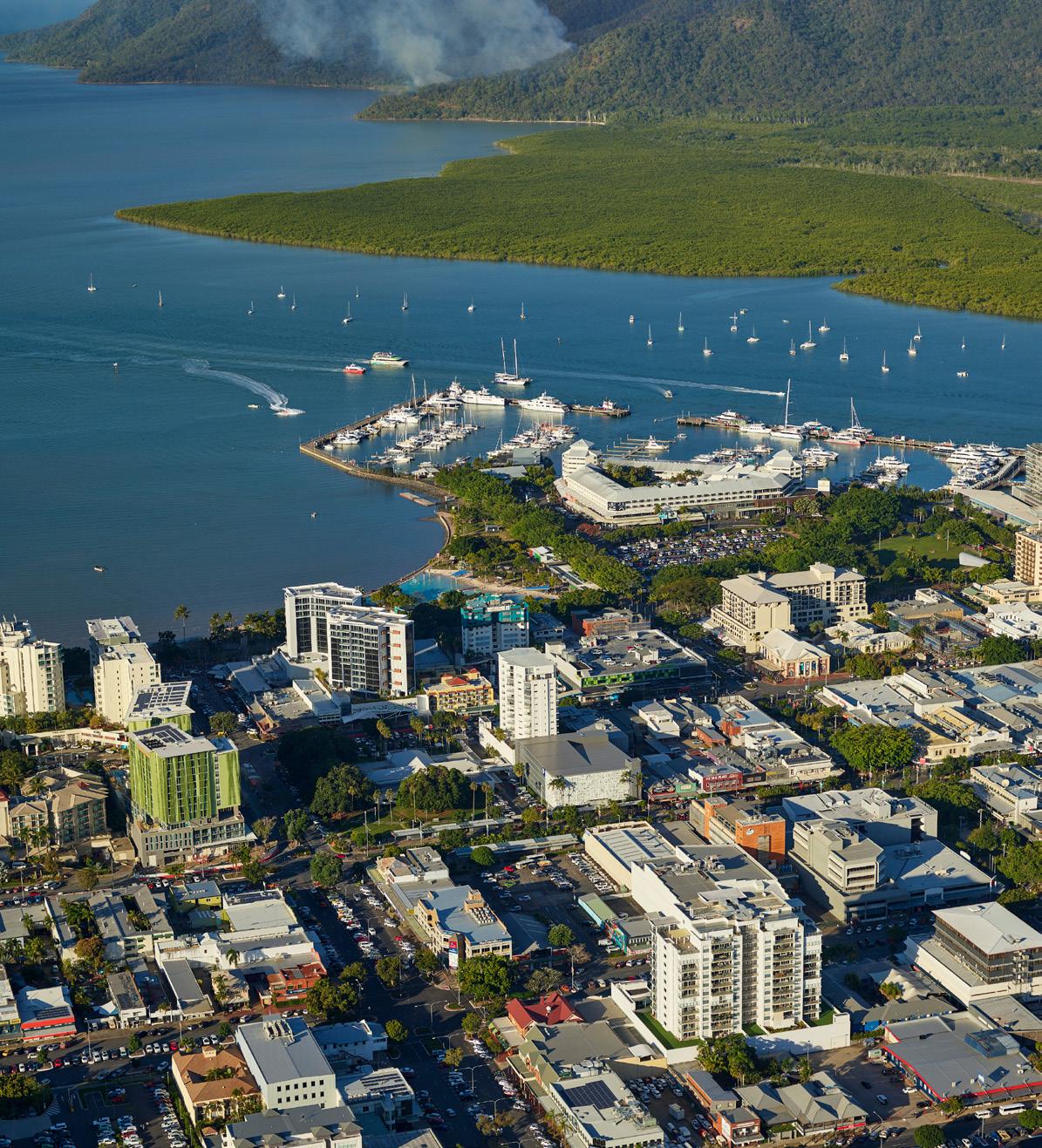
Forging a resilient and robust future for Far North Queensland
THE COMMITTEE FOR TROPICAL NORTH QUEENSLAND
Tropical North Queensland, the most populous region in Northern Australia and boasting one of the most diverse regional economies nationwide, continues to play an outsized role in contributing to the prosperity of Queensland.
No region in Australia is more internationally connected than Cairns and Tropical North Queensland; our geographic proximity and unique connections to the Asia Pacific and beyond are what truly makes Cairns Australia’s most global regional city.
Tropical North Queensland’s unique advantages brings with it increasing population pressures requiring strategic investments into health, regional connectivity and food, water, and housing security that will sustain us to 2034 and beyond.
The priorities outlined in this document, enable the region to enhance its liveability, sustain a growing population and foster economic growth while continuing to play host to millions
of national and international tourists. By 2032, the region will require an additional 65,000 beds to provide for tourists alone. And tourists and residents alike depend on secure and safe water supply, reliable connectivity and access to health services.
The recent record-breaking flooding highlighted the vulnerability of the region from an infrastructure and transport perspective. How we invest and plan for our future is critical to ensure a prosperous, climate resilient future.
These priorities, supported by government, will be fundamental in delivering a prosperous future for the Tropical North Queensland region.
Many thanks in advance for your consideration of this document.
Pg. FNQ Health & Innovation Precinct Cairns Health and Innovation Centre $250m required. Multinational research and education partnerships. Capacity to capitalise on global tropical medicine and rural generalist niche. Attract and retain skilled clinicians, researchers and innovators. 04 General Aviation Common User Hangar $45m required. Complement Cairns Airport’s $25m investment. 100 construction jobs. Ongoing skilled job creation, attraction and retention. Double general aviation sector. 09 Cessna Caravan Training Simulator $8m required. Australia-first Cessna Caravan (Type-D) flight simulator 10 Short-term Accommodation $10m required. Addressing accommodation shortage. 11 Food & Water Security Cairns Water SecurityStage 1 Additional $128.5m required. Secure water for residents and visitors Boost disaster resilience with extra water source. 13 Lakeland Irrigation Area Scheme Formation of an independently chaired Mobilisation Group . Expand FNQ irrigated agriculture for food security and create economic opportunities in Cape York Peninsula. 14 Etheridge Shire Agricultural and Irrigation Precinct Project $380k (50:50) for initial stage required. Maximise prime agricultural area, $900m annual value. Create a central service hub to cut living and supply costs. 15 North Johnstone Diversion Release the final Regional Water Assessment by June 30, 2024. Expanding northern Australia’s agricultural productive capacity. Increasing northern Australia’s contribution to GDP. 17 Foreword P 2 ADVANCE CAIRNS | 2024-25 QUEENSLAND BUDGET SUBMISSION
Project Investment Opportunity
Cairns Northern Beaches Access: Cairns Western Arterial Road, Redlynch Connector to Captain Cook Highway Duplication (CWAR)
Project Investment
Pg. Cairns Housing Crisis JCU Purpose-Built Student Accommodation $100m required. Expand research and education. Enhance service capacity. Investment prospects. Improved health outcomes. 19 Road Connectivity Tablelands Access: National Land Transport Network Amendment of the National Land Transport Act 2014. Improved connectivity for the region’s agricultural production hubs on the Atherton Tablelands. Provides pathway towards increased connectivity between key national security assets. 21 Tablelands Access: Palmerston Highway Significant investment required. Increased resilience. Unlock and secure critical supply chains, improving the region’s freight network and waste management industry. 22 Tablelands Access: Kuranda Range Road $20m required for detailed business case. Increased economic and social expansion. Enhanced supply chains, improving region’s freight network. Improved connectivity and safety. 23
Opportunity
$190m allocated over three years. Accelerated delivery of project is required. Contributes to regional economic growth. Increase network reliability, and improve overall efficiency. Encourage and facilitate the use of public and active transport options. 25 Cairns
upgrade
$225m allocated over three years. Delivery of master plan finalised
Improve regional connectivity and accessibility. Improve safety, reducing number and severity of crashes. Encourage use of active and public transport. 26 Savannah Way (Gulf Section) Allocation of funds distributed to LGA’s over 10 years. Enhance economic and social advancement. Improve safety, resilience and connectivity. Support local workforce development and retention. 27 Cairns Marine Precinct Common User Facility $360m committed. Accelerated delivery of project is required. Accelerated delivery increases capability, solidifying Cairns as a leading maritime MRO destination. 4,600 ongoing jobs. 29 TAFE Queensland Great Barrier Reef International Marine College $16m committed. Shovel ready. Increased education and training capacity to support increased demand. 37 construction jobs. 31 ADVANCE CAIRNS | 2024-25 QUEENSLAND BUDGET SUBMISSION P 3
Northern Beaches Access: Captain Cook Highway, Cairns CBD to Smithfield,
(C2S)
by end of 2023.

FNQ HEALTH & INNOVATION PRECINCT
The Cairns and Hinterland Hospital and Health Service’s operations extend across Far North Queensland to some of the most remote communities in the state, with a population increasingly experiencing complex, chronic conditions above national averages. Cairns Hospital is the only major referral hospital in FNQ, also providing care to patients from Cape York and the Torres Strait.
Expanded health services, clinical research, and education are critical to meet the health needs of FNQ’s growing population. Significantly, the region also supports a growing current visitor population of close to three million a year. Our region’s Hospital and Health Services, supported by James Cook University (JCU), the Northern Queensland Primary Healthcare Network, CQUniversity, TAFE Queensland and other tertiary institutions, are ensuring that Cairns grows its own medical, nursing and allied health workforce, to expand its clinical services and to translate research into practice to improve health outcomes for FNQ communities. Embedding research and expanding education will enable CHHHS to provide best-practice healthcare and support Cairns Hospital’s transition to tertiary hospital status within the next six years. With more than 2,000 health related student placements in 2023 alone, JCU is already a strategic partner with a growing investment into the Cairns region, such as the recent opening of a medical school allowing students to complete their full six-year training locally and the construction of JCU’s Cairns Tropical Enterprise Centre which will provide facilities for clinical teaching, training and research.
P 4 ADVANCE CAIRNS | 2024-25 QUEENSLAND BUDGET SUBMISSION
Cairns Health and Innovation Centre
The Cairns and Hinterland Hospital and Health Service (CHHHS) must support a growing population whose demand for healthcare services consistently outstrips population growth. The CHHHS annual report for 20222023 highlighted that Cairns Hospital supports an estimated resident population of 289,000, including the regular provision of acute medical services for residents of the Cape and Torres region, an area larger than Victoria 1. This is in addition to catering for the region’s tourist population of close to three million for 2023. Cairns Hospital continues to see increased demand on its Emergency Department with more than 88,000 presentations to the Cairns Hospital Emergency Department alone in 2022, a 2.2% increase on 2021.
Combined with an estimated population growth of 2.13% (compound annual growth rate) per annum and an ageing population, it is estimated that by 2032 an additional 67,000 people will reside in the catchment area with more than one in five residents aged over 60 –a third more than the national average 2
The Cairns Health and Innovation Centre (CHIC) provides a platform for the Far North to substantially boost the health capability of the region which directly will result in significant improvements in the health outcomes of Far North Queensland residents as well as visitor population. The investment into the Innovation Centre underpins a significant opportunity to bring in international universities, researchers and a workforce that would benefit the region and indeed the nation.
Expanded health services, clinical research and education are critical to meeting the needs of FNQ’s large and growing population. Cairns Hospital faces a number of sustainability challenges, including:
• Short- and long-term infrastructure capacity – Cairns Hospital is now at capacity across all bed types with no hospital bypass option. By 2036-37, this gap is predicted to be more than 360 beds. Capacity is a critical risk and immediate planning is needed for a new acute clinical services building to ensure sustainable health service delivery for the medium term.
• Site constraints and resilience – Cairns Hospital is the smallest block of developable land for comparable hospitals, and the waterfront location creates service continuity risk (through flooding and storm surge exacerbated by climate change).
• Workforce and innovation – Innovation, continuing education and translational research is the key to attracting and retaining the appropriately skilled workforce that is required to meet the growing health demands of the Far North.
Discussions are underway between the CHHHS and JCU about joint master planning the Cairns precinct site to ensure a capitalisation of enhancing the health, research and education possibilities that will not only provide significant advantages to the health workforce, the community and their health outcomes, but also create meaningfully more jobs in the data sciences, robotics, innovation and engineering disciplines boosting FNQ’s reputation for translational research.
The uniqueness of FNQ’s environment means the Innovation Centre will focus on drawing on the Far North’s natural assets, partnerships with First Nations, domestic and international partners with a desire to make generational improvements to the health and wellbeing of all Australians. The proposition of the CHIC allows an expansion of the health and research precinct and will deliver material economic benefits that include job creation, tourism, increased international partnerships and linkages including with some elite level international universities. This will in turn benefit the health sector through incorporating innovative models of care and technology that will remove the volatility of the current workforce shortage felt in the health sector, and particularly in FNQ. The Innovation Centre investment will bring benefits across multi-sectors including travel and tourism, retail and housing development. Securing the knowledge economy in the Far North ensures the resilience of the region and is complementary to
The Cairns Health Innovation Centre business case is a milestone towards creating a purpose-built education and training, research, and innovation precinct for our region.
— Leena Singh, Chief Executive, Cairns and Hinterland Hospital and Health Service 2023
“ “ ADVANCE CAIRNS | 2024-25 QUEENSLAND BUDGET SUBMISSION P 5
the tourism and agricultural sectors which will also benefit from the multi-disciplinary mix of research and development specialties.
The CHIC is fundamental in achieving Cairns Hospital’s transition to a tertiary hospital, enabling it to deliver world-class, high-quality care to address the critical current and future health challenges facing FNQ. This will result in more complex medical and surgical services, with more skilled and highly trained clinicians servicing a growing population which includes a population from the Cape and Torres Strait living with material health and wellbeing deficits, as well as serving a growing international and domestic tourism population. The region is forecast to attract close to four million visitors in 2032, placing further demands on the health service, extending beyond the resident population.
To ensure a successful transition, a significant expansion of bed capacity and selected specialty services is required over coming years, such as high specialty needs for older persons, paediatrics, adolescent mental health and other medical and surgical specialties. This will also include new expanded clinical and professorial roles. This will be delivered through strong national and international partnerships, the right infrastructure, and expanded provision of safe and sustainable clinical services for FNQ.
Opportunity
• Increased service capacity, ensuring equitable access across FNQ.
• Multinational research and education partnerships.
• Capacity to capitalise on global tropical medicine and rural generalist niche.
• Attract and retain skilled clinicians, researchers and innovators.
• Improve First Nations People health and wellbeing.
• Increased climate resilience.
• Improved health and wellbeing outcomes for Queenslanders.
• Growing the regions knowledge economy and ensuring the economic resilience of the Far North.
Project Status
The Cairns Health and Innovation Centre detailed business case was submitted in December 2023 for final investment decision making by Government.
Recommendation
FNQ Health & Innovation Precinct Sources
1 The State of Queensland (Cairns and Hinterland Hospital and Health Service) Annual Report 2022-2023
2 The State of Queensland (Cairns and Hinterland Hospital and Health Service) Annual Report 2020-2021
Phase 1 (2022-26)
Capacity Expansion Program
Funded
• Relocate subacute care offsite to free up capacity for acute services at Cairns Hospital (by June 2023).
• Develop the Cairns Surgical Centre to enable increased surgical capacity and to increase bed capacity at Cairns Hospital for additional acute care beds.
The Queensland Government commits to capital funding of about $250m for the detailed design and construction of the Cairns Health and Innovation Centre as per the detailed business case findings and supports the establishment of a research and education precinct to boost the economic resilience of the Far North.
Cairns Health and Innovation Centre (CHIC)
Pending funding commitment
• Invest in construction of new Health and Innovation Centre.
• Deliver new, innovative care models – virtual health, ambulatory care, clinical trials (reducing bed pressures at Cairns Hospital).
• Facilitate the partnering of third party domestic and international investors to develop a Far North Innovation, Research and Education precinct.
Phase 2 (2022-36+)
New acute clinical services building (Transform)
Pending planning and funding commitment
• Invest in an expanded hospital footprint to meet projected services demand.
• New Acute Services Building to meet critical care needs –expanded emergency dept, theatres, ICU, wards and helipad.
• Expanded sub-acute services.
• Cairns Hospital completes its transition into a full tertiary level hospital (2030).
P 6 ADVANCE CAIRNS | 2024-25 QUEENSLAND BUDGET SUBMISSION

ADVANCE CAIRNS | 2024-25 QUEENSLAND BUDGET SUBMISSION P 7

GENERAL AVIATION
Fuelling connectivity across the region and expanding a skilled workforce
Cairns Airport’s thriving General Aviation Precinct is a major contributor to the regional economy, home to over 100 businesses including major maintenance, repair and overhaul organisations, education and training providers (Cairns Aviation Skills Centre and CQUniversity), freight consolidation services, and rescue and charter flights. Far North Queensland’s maintenance, repair and overhaul sector is vital to the region’s connectivity, servicing fixed wing and rotary aircraft that ply the Cape, Torres Strait, Papua New Guinea and the wider Asia-Pacific. These services ensure emergency and humanitarian aid as well as FIFO flights remain in air and provide critical connectivity to areas where it matters most. With Jet Aviation the only and largest independent heavy maintenance provider for large turboprop and regional jet aircraft in Australia, with Skytek the only independent maintenance, repair and overhaul operator for fixed and rotary wing on the East Coast of Australia and with an early-stage proposal for an advanced fibre and composites manufacturing and repair facility underway, the precinct has significant opportunity waiting to be unlocked.
P 8 ADVANCE CAIRNS | 2024-25 QUEENSLAND BUDGET SUBMISSION
Common User Hangar
While demand for turboprop maintenance in Cairns continues to grow, another significant opportunity is regional jet maintenance, with about half of the fleet currently maintained overseas.
Although regional jets are capable of long ferry flights to access cheaper international maintenance providers, airlines with high asset utilisation prefer to have their jets maintained domestically to reduce downtime.
Cairns is the only regional airport in Australia with international capacity to attract new customers to the region with two highly capable mainenance, repair and overhaul (MRO) operators working at close to capacity but willing and able to expand if infrastructure were available.
Latest economic data shows Cairns’ aircraft manufacturing and repair services sector contributed $36m value added to the regional economy, supporting more than 372 jobs1. Overall, the MRO and training facilities at the Cairns Airport consists of about 700 employees, as well as a steady stream of apprentices (two MROs alone offer 25 apprenticeships annually) providing critical training and career pathways in trades as well as highly skilled professional roles. Overall, the general aviation sector contributed over $88m and 913 jobs1.
Steadily increasing demand has seen MROs outgrow ageing hangar and maintenance facilities in the Cairns Airport General Aviation Precinct, leaving aircraft grounded and resulting in the precinct turning away an estimated $15m in business in the past 12 months due to lack of adequate infrastructure.
There is a pressing need to develop a new, fit-for-purpose common user hangar facility. This will offer economies of scale in construction and will enable MROs to meet urgent demand while ensuring the continuation of critical services as well as growth and expansion of the sector. This need is all the more pressing after the General Aviation Precinct was inundated with floodwaters in the wake of ex-Tropical Cyclone Jasper, causing widespread damage and disruption. A new Common User Hangar would be constructed above 100-year flood levels and provide resilience to the MRO sector.
A commitment towards the Common User Hangar complements Cairns Airport’s current plans to significantly expand capacity to support growth in the general aviation sector. As part of its Eastern Aviation Precinct development, Cairns Airport is investing ($25m for Stage 1) to create new infrastructure (taxiways, aprons, roads and services) to support the growth of its aviation partners onsite. This infrastructure will unlock opportunities for a new aeromedical precinct, a new MRO precinct with capability for larger aircraft and dedicated heliport
infrastructure that will remove any conflict with runway operations, and will lead to an increase in the frequency of scenic reef flights.
Cairns Airport is committed to be net zero (Scope 1 and 2) by 2025, and more broadly is supporting the transition of the aviation industry where possible. By 2025 all airport tenants will be supplied by 100% renewable power from a local renewable project. The airport is also working with industry to facilitate sustainable aviation fuel on site and will seek to provision for new infrastructure within the new Eastern Aviation Precinct to accommodate this initiative.
Dedicated spaces to support aeromedical and emergency activities in addition to a specific helicopter precinct which would reduce delays and boost runway capacity for all air services including passenger and cargo.
Opportunity
• Expansion of Far North Queensland’s general aviation sector.
• Provide increased disaster resilience to the general aviation sector.
• 100 jobs supported throughout construction.
• Skilled and non-skilled job creation, attraction and retention; creation of additional apprenticeships and career pathways.
• Investment attraction across the general aviation sector, as well as downstream industries.
• Common user model will allow for maximum commercial uptake and will complement Cairns Airport’s initial $25m investment in the new Eastern Aviation Precinct.
Project Status
Existing Cairns MRO operators are severely constrained, operating at capacity and turning work away. Investment of $45m required to develop a common user hangar.
Recommendation
The Queensland Government invests $45m to deliver a 10,000m2 hangar within the Cairns Airport Eastern Aviation Precinct which is to be operated under a common user model incorporating commercial general aviation partner engagement, with ownership of the hangar to revert to the state.
General Aviation Sources
ADVANCE CAIRNS | 2024-25 QUEENSLAND BUDGET SUBMISSION P 9
1 Cairns Airport. Economic Assessment & Airport Census, September 2022
Cessna Caravan Simulator
The Cessna Caravan (C208) light aircraft is ideally equipped for versatile, remote operations in demanding conditions and is widely used across the region by a number of commercial operators. It is the most commonly used aircraft by Far North Queensland-based MAF International (MAF), the world’s largest humanitarian airline and the proponent of the simulator.
The C208 aircraft provides critical access to remote communities which would otherwise be isolated. There are just under 130 registered in Australia.
Pilot training currently takes place within aircraft, allowing little room for pilot error in treacherous and remote terrain and unpredictable climactic conditions. A number of crashes have occurred in this aircraft type with the simulator providing for a risk-free training experience.
A Cessna Caravan simulator would be the first of its kind outside the United States and would provide a steady stream of new pilots prepared in a safe environment for unique regional conditions. It would also ensure that current pilots are upskilled on an ongoing basis. Together with the Cairns Aviation Skills Centre (CASC) and Aviation Australia, Australia’s only Cessna Caravan simulator would cement Cairns as a national flight training hub, complementing the pilot training offered through CQUniversity’s aviation school.
It is anticipated that the establishment of the simulator in the city could lead to a CASA mandate requiring pilots across the nation to undertake training in Cairns. The simulator would align with the training offered at the Queensland Government’s Cairns Aviation Australia’s facility within the industry led CASC and also attract pilot trainees from across the region, helping build capacity in the Pacific, particularly in Papua New Guinea (PNG). MAF currently trains pilots in East Arnhem Land and hopes to further expand its Indigenous training program.
• Australia-first Cessna Caravan full flight simulator, cementing the Far North as a premier aviation training hub.
• Significant potential to establish Cairns as the national hub for pilot training for the Cessna Caravan, in partnership with the Queensland Government’s Aviation Australia at the CASC.
• Introduce new standards of safety and enhanced pilot training for pilots who typically service rural and remote parts of Australia, PNG and the Pacific.
• Free up aircraft for commercial, humanitarian and emergency use in the region.
• Train and build capacity throughout Indigenous communities, as well as PNG and the Pacific (adopting a model similar to the current Pacific Maritime Security Program conducted in Cairns at the TAFE Great Barrier Reef International Marine College).
Project Status Opportunity
The lack of access to simulator training for Cessna Caravan pilots is limiting critical commercial and humanitarian services, and creating material safety risks. Investment of $8m required.
Recommendation
The Queensland Government invests $8m capital cost to establish Australia’s first Cessna Caravan full flight simulator (to be operated on a common user model) to ensure safe training across commercial and humanitarian sectors, establishing the city as the only such centre for specific pilot training across Australia and the wider Asia-Pacific.
We calculate that a simulator would reduce by two-thirds the time spent burning fuel because of training in the air, which makes it much better for staff, the aircraft, and most importantly the environment.
— MAF International Chief Operations Officer Norman Baker, 2023
“ “ P 10 ADVANCE CAIRNS | 2024-25 QUEENSLAND BUDGET SUBMISSION
Short-term Accommodation
A key element of the General Aviation sector’s expansion is the need for quality short-term accommodation within the airport precinct. This is needed to support professional, skilled and contract workers as the region grows, and to provide much-needed affordable purpose-built housing for students. This project would free up housing within the city in an environment which is highly constrained by the lack of accommodation with impacts being felt across the student and general population.
The overall Cairns Airport accommodation precinct development will cost an estimated $80m, incorporating 180 short term accommodation self-contained apartments including studios, 1 bedroom and 2 bedroom apartments, and a 200+ bed student accommodation facility. This accommodation precinct is to be built on 10,041m2 of land within the airport Business Park precinct and would provide accommodation for student; travellers and workforce needs, including aviation engineers, avionics, pilots, hospitality, medical, government transient workers and allied health students, and other students and trainees attached to the airport sector. The development will also include conference facilities for corporate meetings and workshops, swimming pools and outdoor recreation areas, a gymnasium, laundry, and café facilities.
The student accommodation component of the new accommodation project within the aviation precinct could accommodate more than 200+ beds. The design comprises two, three and four bed quality apartment style student accommodation. Each bedroom has its own bathroom with shared living facilities.
Upon completion, ownership of the total development, including the student accommodation would transfer immediately to the Queensland Government as the ultimate landowner. The project is being developed by Cairns-headquartered MiHaven.
A significant escalation in construction costs over the past two years (in some cases, costs have almost doubled), has meant that development of new student accommodation is not commercially viable: with student rental affordability capped about $250 to $290 per week, therefore funding from the Queensland Government is fundamental to enable student accommodation to be incorporated into this project.
Without the Queensland Government’s support for this student accommodation development, this portion of the project will not proceed which would have a knockon impact on both existing constrained housing stock in Cairns, and into the region’s jobs and skills shortage.
Construction of this student accommodation could start as early as October 2024. The project is subject to the requirements of Cairns Airport acting as the planning authority which allows for a faster approvals process. Site utilities are already in place.
Opportunity
• Fast-tracked construction – ready to commence as early as October 2024.
• Facilitate student accommodation development, alleviating pressure on the city’s constrained housing stock.
• Infrastructure would vest to the Queensland Government as the head lessor upon lease completion.
Project Status
Design work has been completed with work on the construction documentation underway.
An application for development approval from the airport is imminent.
If this timeframe is met, it is expected that the project will be ready for site works to begin in the last quarter of 2024. It is expected that construction of the project in its entirety will take less than three years.
Recommendation
The Queensland Government invests $10m towards development of quality short-term accommodation within the Cairns Airport Precinct to address critical demand, specifically for students, as part of a broader accommodation development project.
ADVANCE CAIRNS | 2024-25 QUEENSLAND BUDGET SUBMISSION P 11
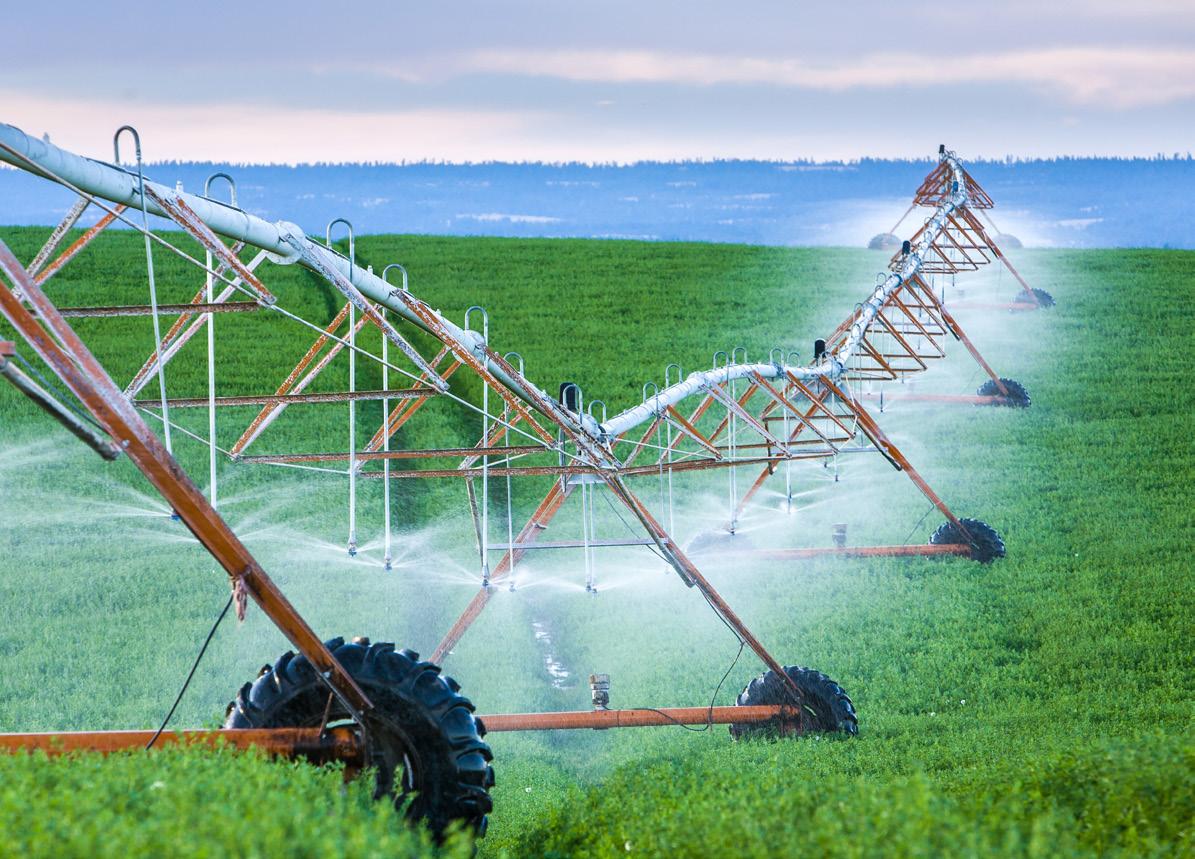
FOOD & WATER SECURITY
Water and food security have become priority national policy issues on the back of record drought periods in Australia, as well as disruption to supply chains through COVID-19 and recent flooding events. The ability to meet increased demand for fresh Australian produce from Far North Queensland is at major risk due to the lack of a long-term water implementation strategy. Agricultural exports are vital to FNQ with the industry sector output currently valued at $2.7bn 1 , constrained mainly by factors such as irrigation and access to market. Urban demand also continues to increase with Cairns’ population growth averaging 1.9% per annum over the past 10 years 2 . This, combined with a long-running history of three million tourists visiting FNQ annually, means an effective and multi-faceted water supply strategy is required to ensure the growing needs of the region can be met.
P 12 ADVANCE CAIRNS | 2024-25 QUEENSLAND BUDGET SUBMISSION
Cairns Water Security – Stage 1
Due to continued population growth, forecasts indicate Cairns will be at risk of a drinking water shortfall by 2026. Demand management has and will continue to play an important role in managing the city’s water resources (per capita water use in Cairns is down 35% since 2006), but access to a new water supply is now critical. The Cairns Water Security – Stage 1 (CWSS1) project meets that need securing urban water supply well into the next decade. The project is Cairns Regional Council’s (CRC) number one advocacy priority.
To reduce the burden on Cairns residents and ratepayers and secure the city’s water needs, CRC has already secured $215m (50:50) from the Queensland and Australian Governments towards the project’s capital cost. However, since the preliminary business case was completed in 2021-22, inflation, materials, labour shortages and cost of living pressures have seen significant increases in the cost of infrastructure projects across the nation, including the CWSS1 project. The total capital cost of the CWSS1 project has now increased to $472m 3
In the wake of the unprecedented flooding caused by ex-Tropical Cyclone Jasper, Advance Cairns supports and joins CRC’s calls for significant disaster relief and future-proofing of the city’s water security, requesting that state and federal governments increase their CWSS1 contribution to $236m each. The recent event highlighted the need for access to an additional water supply and treatment plant after treated water storage dropped to 3% (two hours’ supply) and, as a result, the Cairns and Hinterland Hospital and Health Service was required to prepare for possible patient relocation. Additional funding will not only allow CRC to focus efforts on restoring and repairing services impacted by the flooding but will provide future disaster resilience for the community.
• Secure water needs of 198,000 residents and visitors (as well as industry and surrounding regions which rely on Far North Queensland’s primary population and service centre).
• Reduce cost of living pressures, saving Cairns households an estimated $7,320 per household over 15 years.
• Build disaster resilience with an additional source of water intake and treatment.
Project Status Opportunity
The procurement process for the CWSS1 design and construct tender was completed in December 2023 with the tender awarded to John Holland Queensland.
Construction is scheduled to commence in mid-2024 and be completed by mid-2026.
Joint state and federal funding of $215m ($107.5m each) has already been committed to the project. Additional funding is now required to support project delivery.
CWSS1 has overwhelming support from the Cairns community, industry and business sectors and all local, state and federal members of parliament.
Recommendation
The Australian and Queensland Governments commit an additional $128.5m each towards the Cairns Water Security – Stage 1 Project, bringing the total commitment to $472m ($236m each State/ Fed) with allocations to be made in the 2024-25 Queensland and Federal Budgets (Budget year and across the forward estimates) in accordance with the table below.
Government 2023-24 2024-25 2025-26 2026-27 Total Australian Governement $6m $110m $85m $35m $236m Queensland Government $6m $110m $85m $35m $236m
ADVANCE CAIRNS | 2024-25 QUEENSLAND BUDGET SUBMISSION P 13
Lakeland Irrigation Area Scheme
Regional Development Australia (RDA) Tropical North has completed a detailed business case for development of the Lakeland Area as a significant irrigated agricultural area. The business case was funded from a $10m grant through the National Water Infrastructure Development Fund (NWIDF).
Expansion of the 1,800ha area is currently limited due to a lack of adequate and reliable water. The preferred project includes a 296,000ML dam to irrigate up to 10,000ha of identified high quality land, taking one percent of outflow of the Mitchell River to the Gulf of Carpentaria. The scheme will directly generate up to $382m p.a. in agricultural production with an increase of up to $213m p.a. in Gross Regional Product (GRP). The scheme would also significantly contribute to population growth and boost region wide economic productivity, with up to $300m in additional GRP.
Bilateral government support is now required to progress the development approval processes for the project, support a proponent through the detailed design stage (including funding through the NWIDF) and accelerate the review of the Mitchell River Water Resource Plan.
Recommendation
Opportunity
• Contributes to food security through a significant expansion of irrigated agriculture in FNQ.
• Provides major economic opportunities for a currently disadvantaged area of Cape York Peninsula.
• Provides a pathway to Indigenous engagement through the Western Yalanji Aboriginal Corporation and ‘on country’ presence.
• Provides opportunities for population migration to regional areas of FNQ.
Project Status
The detailed business case is with the Australian Government. While the capital costs are notable, implementation of the scheme in line with previous agricultural schemes with significant government contribution to construction, will make the scheme affordable and realise the substantial identified benefits.

Click here for project map
The Australian and Queensland Governments work together to facilitate and coordinate the development approval processes for the Lakeland Irrigation Area Scheme Project through formation of an independently chaired Mobilisation Group to include representatives of government at state and federal level as well as representatives of the local council of Cook Shire, the Western Yalanji peoples and the Lakeland growers. The purpose is to solve several significant issues including:
• Acknowledgement that development of Lakeland irrigation to its fullest extent be recognised as a catalytic strategic initiative for economic development of regional Queensland and Cape York Peninsula.
• The Scheme be treated like other irrigation areas where only operating costs are recovered.
• A commitment to provide the necessary water from the Mitchell catchment through a new Water Plan.
• Resolution of proposed funding split between government and private sources to allow determination of one or more project proponents.
• The Lakeland Area be declared a precinct with established development rules around environmental protection and urban and rural development, based on a regional basis (not individual landholder basis).
P 14 ADVANCE CAIRNS | 2024-25 QUEENSLAND BUDGET SUBMISSION
Etheridge Shire Agricultural and Irrigation Precinct Project
Etheridge Shire Council, in conjunction with RDA Tropical North, aims to create a discrete agricultural zone through improved planning and development assessment largely within the Etheridge local government area. This includes promotion and development of the region’s agricultural and economic potential through the establishment of an agricultural and irrigation precinct in the Shire.
The project aims to establish protocols that facilitate the approval and expansion of agriculture and horticulture across the precinct on a regional basis. This will include clear delineation of areas required for environmental protection and Indigenous engagement (through Indigenous Land Use Agreements).
Up to 530,000ha of Class A and B soil is potentially available in the Shire, but there are limitations to water access and security, as well as barriers resulting from the high cost to individual farmers to achieve approvals. An estimated 495,000ML of water is available in the Gilbert River catchment area.
Research is currently underway through the CRC for Developing Northern Australia (CRCNA) and the Northern Australia University Alliance as part of the Water Security for Northern Australia program. Including lifting human capacity and skills in the water sector and water quality modelling and design.
An implementation strategy must also be developed and would include other key elements ranging from agreed definition of the project area to a regionwide environmental impact assessment.
A March 2022 proposal identified that $2.5m is now required to develop the implementation strategy to complete the project and leverage work undertaken by CRCNA. The plan will identify the best means of accessing water and irrigating up to 50,000ha of land to diversify crop types and drive economic growth in the area.

Click here for project map
Opportunity
• Unlock the full potential of this prime agricultural area to deliver an annual economic value of around $900m.
• Deliver an environmentally and culturally considered planning framework and facilitate affordable development approvals.
• Encourage secondary development and population migration to grow the regional economy.
• Establish a significant service hub situated midway between the Coral Coast and the Gulf of Carpentaria to assist in reducing cost of living and supply chain costs.
Project Status
A project plan proposal has been presented to Queensland Government (through the Regional Economic Futures Fund grant). This includes an investigation into demand and likely areas of immediate take-up.
The proposal has previously been presented to the National Water Grid Authority (NWGA) and while not a ‘Water Project’ as usually considered, the project does conform to the NWGA guidelines where funding includes “scientific analysis and contributes to regional strategic planning and investing in business cases”.
Opportunities still exist for both state and federal governments to jointly fund the concept.
Recommendation
• The Australian Government accepts that the Etheridge Agricultural Precinct is a relevant initiative under the NWGA.
• The NWGA together with the Queensland Government contributes $380,000 for the initial stage to identify the full extent of the future work required.
• The Australian and Queensland Governments work together to establish a set of Precinct protocols as a model for this and other developments for agriculture, which could be supported by appropriate legislation to facilitate economic development, with least cost for approvals.
ADVANCE CAIRNS | 2024-25 QUEENSLAND BUDGET SUBMISSION P 15
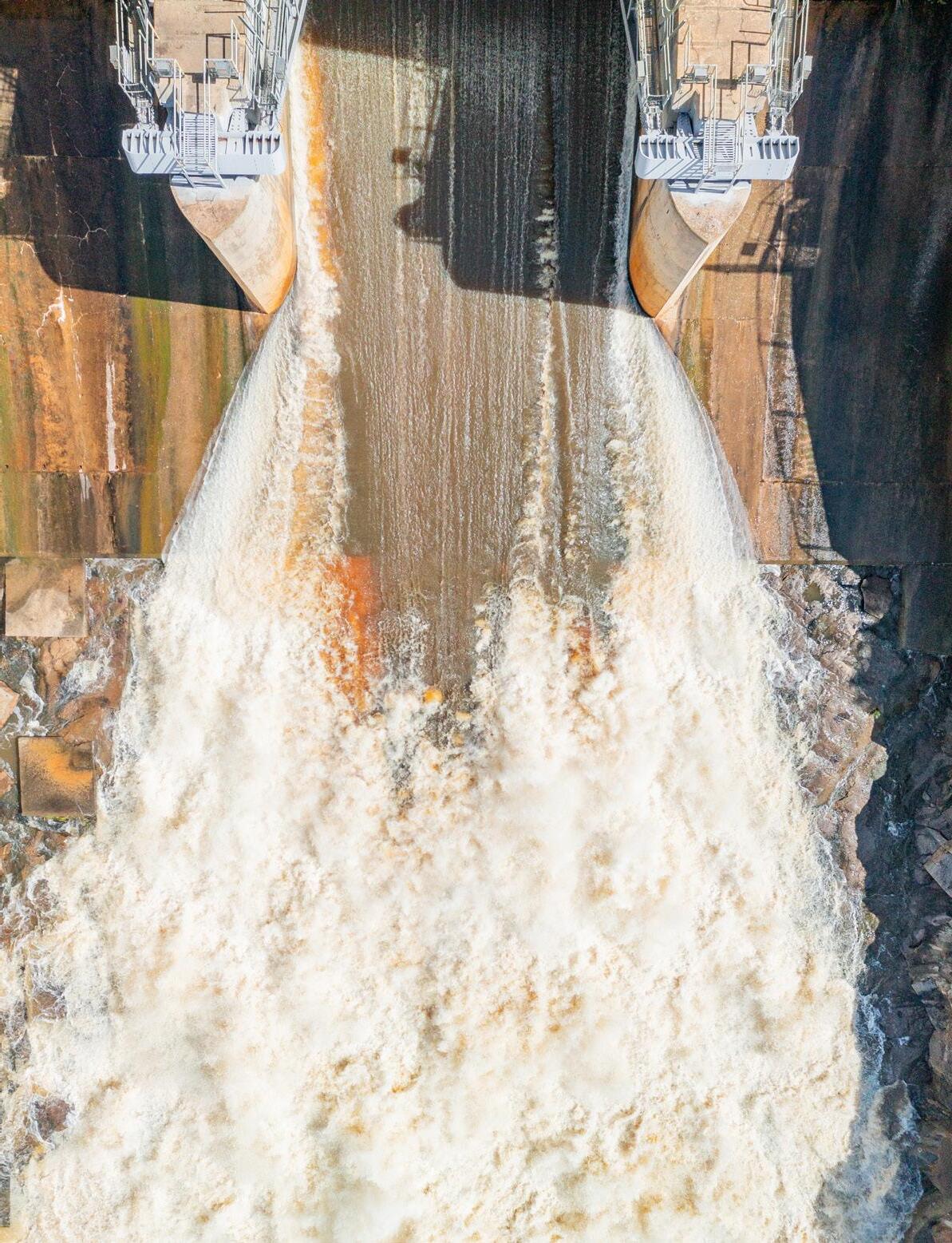
P 16 ADVANCE CAIRNS | 2024-25 QUEENSLAND BUDGET SUBMISSION
North Johnstone Diversion
The North Johnstone diversion involves transferring water from the Johnstone River to Lake Tinaroo, redirecting unallocated water from the river to boost the water supply accessible from Tinaroo Falls Dam.
Sunwater completed a preliminary feasibility study in early 2020 indicating the diversion could deliver up 50,000ML annually into Lake Tinaroo. In 2021 the State Government announced its $9m Regional Water Assessment Program (RWAP) for three regions, one of which was the Tablelands. The RWAP aims to set roadmaps for economic growth, building on previous water supply investigations in each region, taking a comprehensive view of local water needs and identification of gaps to be filled.
The Regional Water Assessments (RWA) will set out how infrastructure and non-infrastructure solutions can be used to maximise water supply in each area and drive economic growth.
The North Johnstone diversion was one of 113 potential water supply and security options considered by the Tablelands RWA and in July 2023 was identified as one of the key projects for action in the release of the draft RWA. While the draft recognised the North Johnstone Diversion as one of the priority projects warranting further investigation, it was not included in the short term (within two years) or medium term (2-5 years) action list.
Instead it was categorised in the long-term priorities for ‘target completion in 10 years and beyond’ with the action stating ‘review supply and demand balance and subject to outcome, initiate DBC (detailed business case) for the North Johnstone Diversion’.
Public consultation on the draft RWA closed in late July 2023. The feedback received has been incorporated into an updated RWA which is now before the Queensland Government for review/approval.
If the Queensland Government adopts the 10-year+ timeline as per the draft RWA, this would result in a significant delay to the project given DBCs typically take up to two years to complete, followed by the need to secure government funding and obtain environmental approvals - all before construction could ultimately begin.
With an estimated cost of $115m-$150m to produce up to 11,400ML annually4, it is imperative that the Queensland Government release the final Tablelands RWA and within that bring forward the North Johnstone DBC target timeframe to ensure current and future water demand is met, securing the agricultural output from the region.
Opportunity
• Expanding northern Australia’s agricultural productive capacity – this is nationally significant given the impact of drought on food and water security in southern Australia.
• Increasing northern Australia’s contribution to GDP through an increase in agricultural production.
• Diversifying northern Australia’s economic capabilities to facilitate investment and reduce reliance on tourism.
• Strengthening Australia’s international competitiveness through proximity to Asia.
Project Status
The draft Tablelands RWA recommended the detailed business case for the North Johnstone Diversion be initiated on a 10-year horizon.
It is imperative that the Queensland Government revisit this timeframe, adopting a shorter-term target completion date for the detailed business case for the North Johnstone Diversion.
Recommendation
The Queensland Government release the final Regional Water Assessment it is currently considering by June 30, 2024.
Within the final RWA, the Queensland Government adopts a medium-term target completion date (2-5 years) for the detailed business case into the North Johnstone Diversion.
Food & Water Security Sources
1 economy.id, Total exports by industry sector - FNQROC, https://economy.id.com.au/ fnqroc/exports-by-industry?BMID=25
2 Cairns Regional Council, Geography & population, https://www.cairns.qld.gov.au/ experience-cairns/facts-figures-history/geography-population
3 Cairns Regional Council, Our water security, https://www.cairns.qld.gov.au/council/ projects-and-priorities/advocacy/security
4 The State of Queensland, Draft Regional Water Assessment - Tablelands
ADVANCE CAIRNS | 2024-25 QUEENSLAND BUDGET SUBMISSION P 17
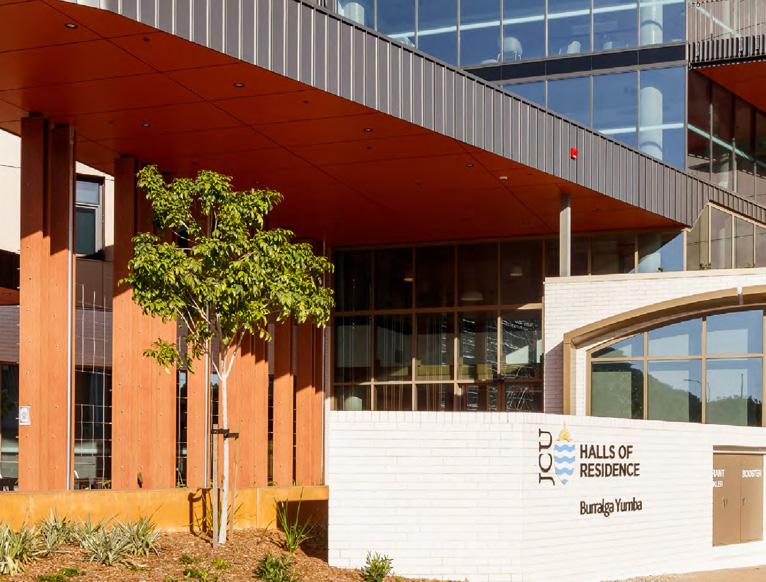
CAIRNS HOUSING CRISIS
Cairns desperately needs solutions to address the housing crisis currently being experienced, a problem made even worse in the wake of Tropical Cyclone Jasper. This crisis is amplified across the economy with housing being a critical enabler of growth and hampering the region’s ability to attract staff across sectors. Identifying available land, funding and building a long-term plan to address a deepening housing crisis is required. Cairns is among the top ten worst regions in terms of unmet housing needs across the nation. Purpose built student accommodation facilities will contribute to provide relief for the housing crisis. Delivering purpose-built student accommodation will ease the pressure on the rental market and release much needed housing stock for wider city needs.
P 18 ADVANCE CAIRNS | 2024-25 QUEENSLAND BUDGET SUBMISSION
JCU Purpose-Built Student Accommodation
Cairns has the lowest rental availability in Australia at 0.09% (SQM Research - November 2023) and has experienced escalating rental costs of 13% in the past two years.
A challenge of this scale needs all levels of government, the not-for-profit sector and the private sector to work together in new and innovative ways.
James Cook University is experiencing strong domestic and international student growth in Cairns. These student numbers contribute to the regional economy and is an important factor in growing Cairns but will put additional pressure on the city’s housing crisis.
The existing self-catered John Grey Halls student accommodation located on the Nguma-bada, Smithfield Campus is at full capacity. In addition, other student accommodation providers are moving out of this student sector, leaving a critical shortage and further exacerbating the housing crisis in Cairns.
To address the immediate housing needs of Cairns, two Purpose-Built Student Accommodation (PBSA) facilities are proposed – one located at Smithfield and one located in the city. Both PBSA facilities, require proximity to the JCU campuses; Nguma-bada – Smithfield Campus, Bada-jali –City Campus, Dugurrdja Precinct – North Cairns and the Cairns Hospital with efficient links to the Cairns Airport.
The two facilities combined would create about 600 beds across the two locations and contribute to the creation of a vibrant and dynamic city of Cairns. These new beds would ease pressure on the Cairns’ rental market by releasing rentals currently occupied by students back to the community.
Land to support the proposed development at the Ngumabada campus is readily available on JCU’s 88 hectare freehold site at Smithfield. JCU is investigating sites in the CBD that would be suitable for the proposed CBD development including potentially locating the second development on the Dugurrdja Precinct in North Cairns.
The PBSA requires capital funding of a total of $100m from Federal and State Governments and is proposed as equal contributions from each. JCU would contribute land, intellectual capital, the governance structure and project management required to successfully deliver these projects.
JCU has a proven track record in the delivery of significant capital developments including the recently (2022) completed $55m, 400 bed Burralga Yumba Student
accommodation complex on the Bebegu Yumba campus in Townsville.
Augmenting existing designs for the recently completed student accommodation without the requirement for DA will allow JCU to fast track these projects and break ground in 2024.
Opportunity
• Scarce freehold land available in both Smithfield and the CBD.
• Address immediate housing needs of Cairns.
• Increase Cairns’ growth, economy and overall liveability.
• Promote continued growth in the education sector and increase economic diversification.
• Positive reflection on Cairns as a student-friendly city and demonstrate commitment to education.
• Supports JCU’s recruitment and retention of a diverse student body through an improved living and study experience.
• Promote diversity through a broad range of accommodation offerings, catering to different needs and preferences.
Project Status
The PBSA requires capital funding of a total of $100m from Federal and State Governments (50:50).
With funding support, JCU can fast track these PBSA projects and break ground in 2024.
Recommendation
The Queensland Government, in partnership with the Australian Government, commits $100m ($50m each) in capital funding for two Purpose-Built Student Accommodation facilities located in proximity to James Cook University’s campuses.
ADVANCE CAIRNS | 2024-25 QUEENSLAND BUDGET SUBMISSION P 19
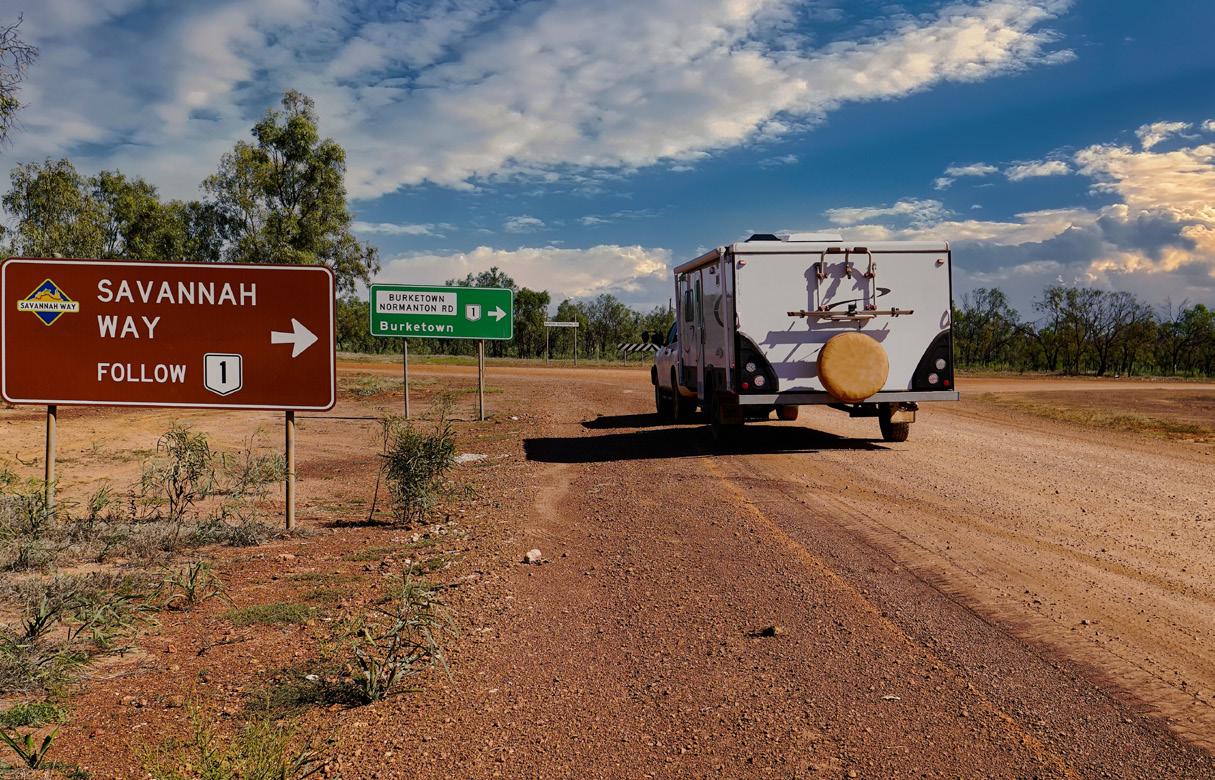
ROAD CONNECTIVITY
An integrated and efficient road transport network is critical for economic stability and growth in Far North Queensland (FNQ), a region of 380,000km 2 which includes some of the nation’s most remote communities. The region’s inland roads and Cairns’ access to the northern beaches and Tablelands play a vital role in enabling the productivity of northern Australia and the contribution to the national economy through improved connectivity to southern markets.
Growth in population, employment, tourism and freight volumes coupled with the increasing importance of food security, means safety and capacity requirements on these roads will only be exacerbated. Investment in FNQ’s road connectivity is crucial to avoid nationally significant productivity losses, to connect rural and remote communities and to ensure continued regional and state economic development.
P 20 ADVANCE CAIRNS | 2024-25 QUEENSLAND BUDGET SUBMISSION
Tablelands Access
The road networks linking Cairns with the vital agricultural, mining and tourism regions of the Atherton Tablelands and beyond are critical enablers of the regional economy. With sizeable growth in both agriculture and mining in the region predicted in the next decade, a safe and reliable road network that enables increased heavy vehicle traffic is vital for economic growth and prosperity in the region. The road network in and out of Cairns acts as the main distribution hub for the region and is essential for further developing the agricultural and mining exports of the region. However, the growing demands for freight and increasing frequency of severe weather events, has strained the existing infrastructure, impacting transport costs and service levels across the supply chain.
>>Projects
National Land Transport Network p.21
Palmerston Highway p.22
Kuranda Range Road p.23
National Land Transport Network
The National Land Transport Network (NLTN) outlines nationally significant road and rail infrastructure links and their intermodal connections. The legislation aims to assist economic and social development through the provision of Commonwealth funding aimed at the improvement of land transport infrastructure.
In recognition of its importance, the Captain Cook Highway, Cairns CBD to Smithfield was added to the NLTN under the 2020 determination1. The objectives of an integrated land transport network include improving national and regional connectivity for communities and industry; improving national, regional, and international logistics; and trade and consistency with viable, long-term economic and social outcomes2.
Continuing the NLTN from Smithfield to Mareeba, and ultimately to Weipa, would meet these objectives and ensure the continued economic and social development of the Atherton Tablelands region and beyond. It would be the next logical step in the network, with Mareeba being the gateway to the region’s agriculture production areas of Atherton Tablelands, Cape York Peninsula, and the Gulf of Carpentaria.
Opportunity
• Improved connectivity between Cairns and the region’s agricultural production hubs on the Atherton Tablelands.
• Increased social and economic outputs.
• Provides pathway towards increased connectivity between key national security assets (Port of Weipa and RAAF Base Scherger).
Recommendation
The Queensland Government works with the Australian Government to amend the National Land Transport Act 2014 to extend the National Highway designation from its current terminus at the intersection of Captain Cook and Kennedy Highways to the intersection of the Kennedy Highway and the Mulligan Highway.
ADVANCE CAIRNS | 2024-25 QUEENSLAND BUDGET SUBMISSION P 21
Tablelands Access
Palmerston Highway
The Palmerston Highway is a key strategic link connecting the southern Tablelands to the Bruce Highway, Port of Mourilyan and Innisfail. As the only road facilitating B-double access to the Tablelands, the Palmerston Highway functions as the region’s primary freight route, playing a critical role in connecting Far North Queensland’s agriculture and mining sectors with southern markets in addition to providing access to tourist attractions and is central to waste management. However, it requires significant investment to maintain crucial access and enhance the resilience of the route.
Catastrophic flooding associated with ex-Tropical Cyclone Jasper has highlighted not only the importance, but the vulnerability of the Palmerston Highway. The highway remained closed for nearly two months, with a temporary single lane section opening in early February 2024, after the road suffered significant structural damage.
Located in the Wet Tropics World Heritage Area, the region’s topography is challenging and particularly susceptible to flooding, landslides and fallen vegetation. In the four years to 2019, 76% of closures to the Palmerston Highway were due to environmental factors. Closures to the highway result in B-double traffic having to either wait, breakdown their vehicle to access an alternative range route (provided these are open) or divert and use the inland route via Townsville, resulting in at least a two hour increase to travel time3
Whilst remedial work on the Palmerston Highway continues, investments in infrastructure resilience, including planning, design, construction and maintenance are essential to ensure the long-term sustainability of the Palmerston Highway, secure supply chains and increase connectivity and efficiency.
• Securing the nation’s access to a major Australian food bowl.
• Increased resilience in the wake of increasingly frequent and severe weather events.
• Unlock and secure critical supply chains, improving the region’s freight network and waste management industry.
• Increased economic and social outcomes.
• Improve safety and security.
• Improve national and regional connectivity.
Project Status Opportunity
Following significant structural damage, the Palmerston Highway reopened with a single temporary lane in early February. However, it is essential the road is upgraded to ensure its long-term viability.
Significant investment from the state and federal governments required.
Recommendation
The unique and complex topography of the Palmerston Highway requires significant investment from both Queensland and Australian Governments to ensure the long-term sustainability and functionality of the highway into the future.
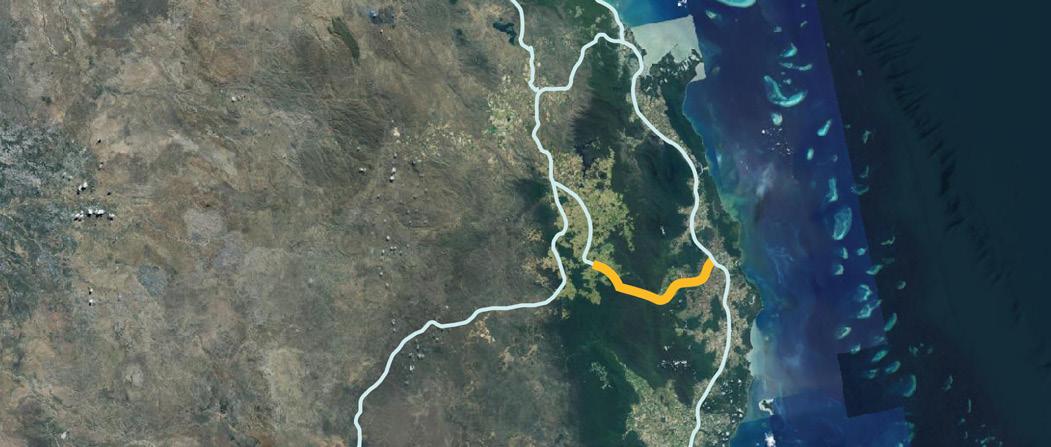
Palmerston Highway National and State Roads 1 1 25 A1 A1 1 CAIRNS INNISFAIL MOURILYAN HARBOUR MAREEBA ATHERTON RAVENSHOE BRISBANE MILLAA MILLAA
P 22 ADVANCE CAIRNS | 2024-25 QUEENSLAND BUDGET SUBMISSION
Tablelands Access
Kuranda Range Road
The Kuranda Range Road (Kennedy Highway, CairnsMareeba section) links Smithfield with Kuranda and is the main coastal gateway to the Tablelands, Cape York Peninsula, and the Gulf Savannah. It is a critical link for commuter, commercial, and visitor traffic in FNQ and a vital strategic corridor underpinning the commercial viability of primary industry producers and exporters in the region in providing access to markets through the Cairns air and seaports, and road links to southern markets4. In recent years, there has been a rapid increase in traffic demand due to growth in tourism, freight movement, and residential development on the Tablelands. A solution to the Kuranda Range Road would not only address FNQROC’s reports that the road is operating beyond capacity with safety and traffic efficiency now at critical levels but would ensure the region capitalises on the full economic potential of the RTDC.
There are other impediments to a safe and efficient transport corridor with the Barron River Bridge (Kennedy Highway at Kuranda) limited to 50.5 tonnes due to concerns over its safety and stability. A business case is currently underway to identify a preferred long-term solution – either rehabilitating or replacing the bridge5. While the business case will identify a solution, its design and construction remain unfunded. It is vital that funding for design and construction is committed as a matter of urgency upon the business case completion in late 2024 to prevent further barriers to Tableland access.
In the meantime, the Australian Government has committed $210m towards safety and capacity upgrades on the Kuranda Range Road. However, a permanent solution to this long-standing issue must be found. It is recommended the Queensland Government work with the Australian Government to ensure that $20m of the $210m commitment is used to conduct a preliminary evaluation and detailed business case into preferred alternative routes to the Kuranda Range Road.
There have been 21 years of studies on the Kuranda Range Road with most recommendations not implemented. As a result, safety, capacity, and efficiency issues are now at a critical point with the recent extreme rainfall in the wake of ex-Tropical Cyclone Jasper highlighting this once again. Failure to address this issue has also resulted in constraints on economic development in the region, as evidenced by the abandoned $600m KUR-World tourism development project. Continued growth in tourism, agriculture, mining,
and population on the Tablelands and beyond mean it is imperative that a solution is developed for Cairns to Tablelands access prior to a major crisis.
Opportunity
• Increased economic and social outcomes, opening up potential new dormitory suburbs for a growing and linear city.
• Unlock critical supply chains, improving the region’s freight network.
• Improve safety and security.
• Improve national and regional connectivity.
Project Status
Installation of Intelligent Transport Systems stations are now underway with construction expected to be completed in early 2024, weather permitting.
Commitment sought towards a preliminary evaluation and detailed business case into preferred alternatives of the Kuranda Range Road.
The current review of the Far North Queensland Regional Plan is nearing completion and early engagement has identified population growth and the linear geographic constraints of Cairns as a major issue. The plan is due to be completed by late 2024.
Recommendation
The Queensland Government commits $20m of the Australian Government’s $210m investment to undertake a preliminary evaluation and detailed business case for an alternative route to the Kuranda Range Road.
p.24 Project map
ADVANCE CAIRNS | 2024-25 QUEENSLAND BUDGET SUBMISSION P 23
Cairns Northern Beaches Access
The road network spanning Cairns’ northern beaches is of regional significance and remains essential to Far North Queensland’s future prosperity and liveability. A cohesive and effective road network between Cairns’ CBD and northern beaches guarantees access to vital healthcare, education and community services in addition to ensured resident, tourist and trade connectivity.
Projects
Cairns Western Arterial Road p.25
Captain Cook Highway p.26
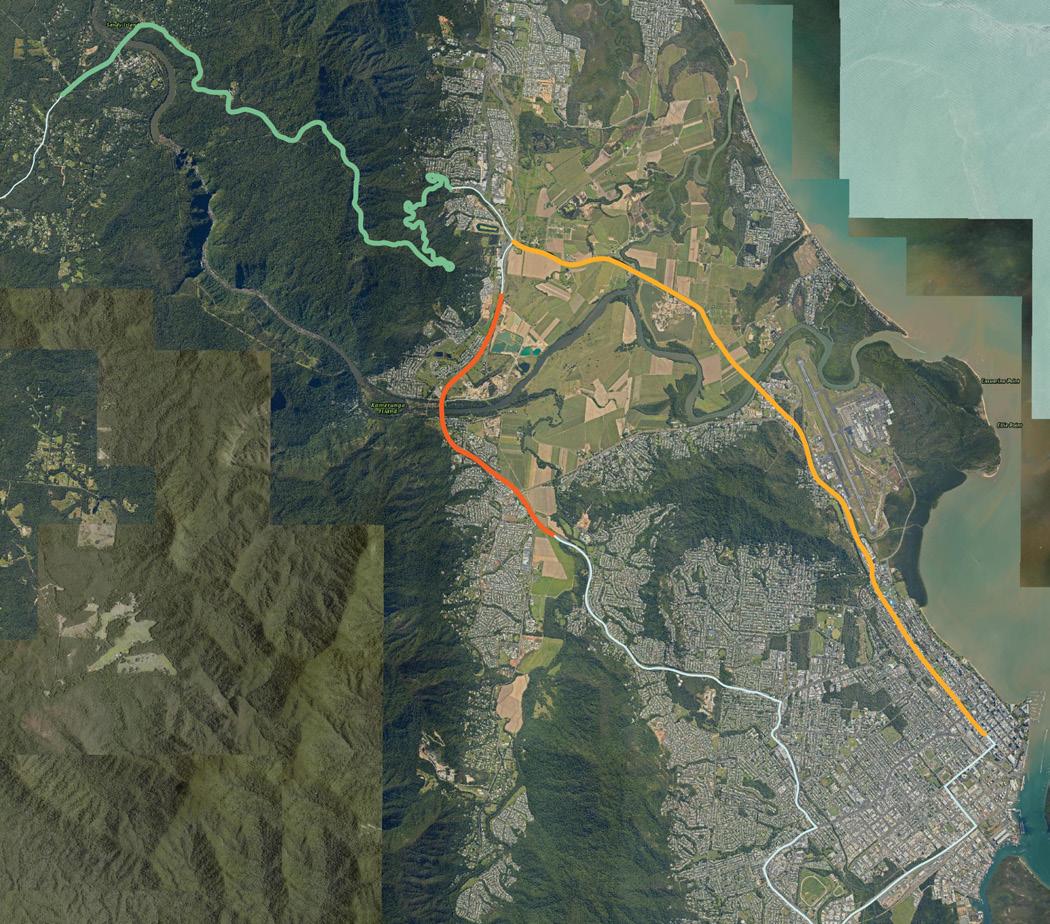
Captain Cook Highway, Cairns CBD to Smithfield, upgrade (C2S)
Kuranda Range Road
HOLLOWAYS BEACH
MACHANS BEACH
>>
CAIRNS CBD
SMITHFIELD
REDLYNCH
KAMERUNGA
CARAVONICA
BRINSMEAD
KURANDA
MAREEBA
PORT DOUGLAS
INNISFAIL
Cairns Western Arterial Road, Redlynch Connector to Captain Cook Highway Duplication (CWAR)
National and State routes 91 1 1 1 A1 91 1 CAIRNS AIRPORT CAIRNS SEAPORT P 24 ADVANCE CAIRNS | 2024-25 QUEENSLAND BUDGET SUBMISSION
Cairns Northern Beaches Access
Cairns Western Arterial Road, Redlynch Connector to Captain Cook Highway Duplication
The Cairns Western Arterial Road (CWAR) is central to freight, commuter and tourism traffic and supports resilience and connectivity when the Captain Cook Highway, Cairns CBD to Smithfield is flooded.
The effectiveness and safety of the road transport network in and around Cairns will continue to be adversely impacted until the CWAR is fully duplicated from Redlynch to Smithfield and in line with an upgrade of major intersections. A total commitment of $300m has been pledged by the Australian and Queensland Governments on an 80:20 basis to duplicate from Redlynch Connector Road to Captain Cook Highway.
The CWAR is considered a priority infrastructure project as the road is heavily congested daily, with about 42,000 vehicles using the road each day 6 . Further, when the Captain Cook Highway floods in the event of a natural disaster or during wet season, CWAR is the only flood-free access route between Cairns, the northern beaches, and the Kennedy Highway. Increasing extreme weather events make this all the more imperative, as evidenced during the recent widespread flooding caused by ex-Tropical Cyclone Jasper where CWAR was one of the few major roads to remain open throughout the flooding, albeit was overwhelmed.
Upgrading CWAR is essential to connecting Cairns’ freight routes with the region’s premier agriculture producing areas (Tablelands, Cape York Peninsula, and Mossman), while also meeting demand for daily commuter traffic. At the 2020 Queensland state election, the Queensland Government pledged $60m to upgrade the CWAR. In the 2021-22 Federal Budget, the Australian Government committed a further $240m to upgrade the remaining single lane sections of the CWAR. Despite the initial commitment made almost four years ago and a total of $300m in funding committed to complete the CWAR with work originally slated to begin in late 20227, construction is yet to commence.
It is now imperative that the Queensland Government works with the Australian Government to resolve the impasse on starting construction as soon as possible.
• Contributes to the growth of the regional economy, building climate resilience.
• Decreases travel time and increases network reliability and efficiency.
• Improves safety.
• Encourages use of public and active transport.
In the 2023-24 Federal Budget, the Australian Government announced a strategic review of its investments across Australia through its Infrastructure Investment Program (IIP). The CWAR duplication was subject to this review.
Construction of Lake Placid Road to Captain Cook Highway (Stage 1) was expected to start in mid-2023, however was delayed due to the IIP Review.
Construction is now set to commence mid-2024.
Advance Cairns urges the Queensland Government to work with the Australian Government to identify and resolve requirements necessary for project construction to commence in accordance with the mid-2024 timeline, preventing further delays to this critical network.
The Queensland Government allocates $190m towards the Cairns Western Arterial Road (Redlynch Connector to Captain Cook Highway duplication) over three years from 2024-25 in accordance with the Queensland Transport and Roads Investment Program 2023-24 to 2026-27
p.24 Project map
Project Status Recommendation Opportunity 240 million Australian Government $ $60 million Queensland Government
ADVANCE CAIRNS | 2024-25 QUEENSLAND BUDGET SUBMISSION P 25
Cairns Northern Beaches Access
Captain Cook Highway, Cairns CBD to Smithfield, upgrade
An integrated and efficient road transport network is critical for economic stability and growth. Population growth in FNQ and the Cairns northern beaches in particular, calls for an immediate response with this corridor plagued by accidents, lengthy delays and bottlenecks.
The road network provides vital access to the region’s resident population of more than 285,0008 (with up to 50,000 tourists during peak holiday season) ensuring accessibility to health, education, community services, and trade. Due to continued population growth, FNQ’s road transport system faces increasing pressure – which is particularly evident on Cairns’ northern beaches. Meeting the growing demand for freight has strained existing infrastructure, impacting on transport costs and service levels across the supply chain.
The need to upgrade Captain Cook Highway to enhance connectivity was recognised by the Australian Government in the National Land Transport Network Determination 2020 The National Highway A1 was extended by the Australian Government in 2020 to the intersection of Captain Cook and Kennedy Highways and Mount Milman Drive, Smithfield, north of Cairns. In 2019, prior to this road re-classification, the Australian Government announced it would fund the road upgrades to Smithfield together with the Queensland Government on an 80:20 basis.
In January 2023, the Department of Transport and Main Roads (TMR) released a preliminary master plan for the Captain Cook Highway, Cairns CBD to Smithfield, upgrade (C2S) outlining proposed upgrades of Stage 1 of the $359m project, subsequently undertaking public consultation. Master planning for the project was due to be completed by late 2023.
Although early works on the project started in 2023, TMR has noted planning for C2S is based on a 2046 design horizon. With Cairns’ population forecast to grow 43% by 20469, the geographic constraints of a linear city bound by the World Heritage-listed mountains and rainforest to the west and the Great Barrier Reef Marine Park to the east significantly constrains both population expansion and the ability to build new roads. Therefore, it is imperative for the future prosperity and liveability of Cairns that the Captain Cook Highway, Cairns CBD to Smithfield, upgrade be undertaken as a matter of urgency to meet pressing current and future needs.
• Enhance regional connectivity.
• Improve accessibility.
• Decrease travel time, increase road network reliability and mitigate loss of productivity.
• Improve safety, reducing number and severity of crashes.
• Encourage use of active and public transport.
Project Status Opportunity
Master planning, including a staged approach for the upgrades is underway. The expected completion date for this work was late 2023.
Once planning work is finalised, TMR will develop a detailed program of construction timeframes for the priority (Stage 1) project.
287.2 million Australian Government $ $71.8 million Queensland Government
Recommendation
The Queensland Government allocates $225m towards the Captain Cook Highway (Cairns CBD to Smithfield upgrade) over three years from 2024-25 in accordance with the Queensland Transport and Roads Investment Program 2023-24 to 2026-27.
p.24 Project map
Road Connectivity Sources
1 National Land Transport Network Determination 2020 (Cth)
2 National Land Transport Act 2014 (Cth)
3 The State of Queensland (Department of Transport and Main Roads), Cairns to Northern Tablelands Access Strategy, July 2021
4 FNQROC, Kuranda Range Road, August 2019, https://www.fnqroc.qld.gov.au/files/ media/original/004/98d/138/272/FNQROC-Kuranda-Range-Road-August-2019-_ DIGITAL.PDF
5 Department of Transport and Main Roads, Kennedy Highway (Cairns – Mareeba), Barron River bridge upgrade, planning, last updated October 30, 2023, https:// www.tmr.qld.gov.au/projects/kennedy-highway-cairns-mareeba-barron-river-bridgeupgrade-planning
6 Infrastructure Australia, Cairns Western Arterial Road capacity, last updated April 4, 2023, https://www.infrastructureaustralia.gov.au/map/cairns-western-arterial-roadcapacity
7 Mark Bailey, “Work wraps up on Harley Street intersection upgrade”
8 Economy.id, Economic Profile, Far North Queensland Regional Organisation of Councils, last updated June 30, 2022, https://economy.id.com.au/fnqroc
9 Queensland Government population projections, 2023 edition; Australian Bureau of Statistics, Regional Population, 2021
10 Gulf Savannah Development, Tourism Survey Report, March 2018, https://www. burke.qld.gov.au/downloads/file/522/gsd-tourism-report-2018
11 Gulf Savannah Development, 2024-25 Queensland Budget submission
12 NWQROC, Developing Northern Australia Conference Paper, July 2023
P 26 ADVANCE CAIRNS | 2024-25 QUEENSLAND BUDGET SUBMISSION
Savannah Way (Gulf Section)
The Savannah Way traverses northern Australia, linking Cairns in FNQ to Broome in Western Australia’s Kimberley. The route is about 3700km long, crossing 15 national parks and five World Heritage areas as it navigates the Top End.
Considered to be in the top 10 road trips of Australia, the self-drive tourism market delivers $69.8m annually into the Gulf region10, with 38% of visitors starting the journey in Cairns.
The Gulf section of the Savannah Way takes in 888km from Forty Mile Scrub west of Mt Garnet to the Northern Territory border, with significant sections of the road already sealed. However, there are many substantial sections that require pavement upgrades, bitumen seal, minor realignment of substandard curves, concrete causeways, and four major river crossing upgrades.
Recognising the need to seal the Gulf section of the Savannah Way, in 2019 the Australian and Queensland Governments committed $62.5m for road upgrades through the Roads of Strategic Importance – next priorities initiative. This will be spent across various shire councils, with a prioritised list formulated in 2021. The Mt Garnet to Carpentaria Shire border section is 510km and requires funding to upgrade the road and floodways for reliability and to meet current construction and safety standards for heavy vehicles, tourists and commuters. This includes approximately $25m to upgrade the low-level river crossing at Gilbert River between Georgetown and Croydon. The river crossing is vital to the Gulf Savannah region and highly susceptible to flooding with unsafe entry and exit points11
Burke Shire to the Queensland border requires further sealing, widening and improvements, including upgrading the causeway crossings at Gregory River (near Tirranna Springs Roadhouse) and Nicholson River (near Doomadgee).
Upgrading the remaining sections is estimated to require:
• $40m to finish sealing 72km between Normanton to Burketown12.
• $41m to seal 55km between Hells Gate and the Queensland border8
• $25m (approx.) to upgrade the Gilbert River crossing.
Opportunity
• Increased economic and social outcomes.
• Improved safety and resilience.
• Improved regional connectivity particularly in isolated and remote communities.
• Supports local workforce development and retention.
Project Status
Major investment has been made to seal around 3,200km of the route.
Further funding required to complete a final 172km in Queensland.
Recommendation
The Queensland Government (in partnership with the Australian Government) supports the sealing and improved flood resilience of the Gulf section of the Savannah Way by investing:
• $40m to seal 72km between Normanton and Burketown.
• $41m to seal 55km between Hells Gate and the Queensland border.
• $25m to upgrade the Gilbert River crossing.
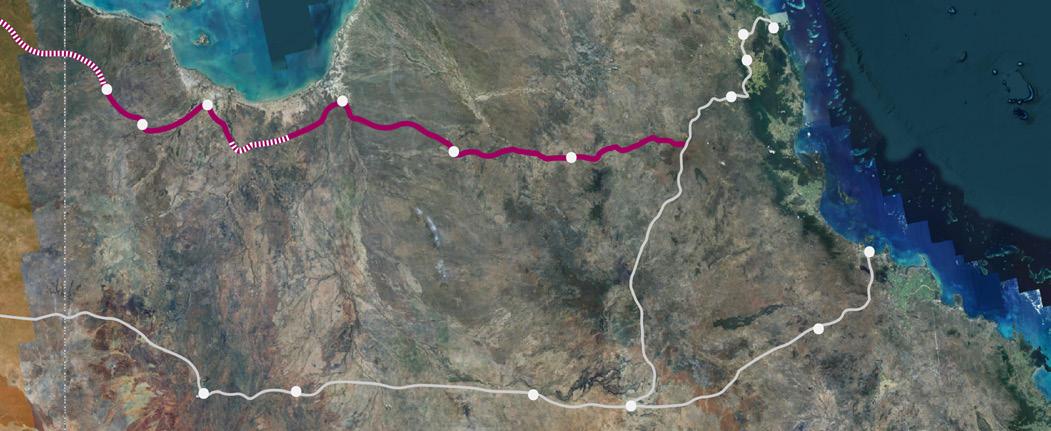
NORMANTON BURKETOWN DOOMADGEE HELLS GATE
GEORGETOWN
CROYDON
HUGHENDEN
CLONCURRY
ATHERTON
TOWNSVILLE
CAIRNS
RAVENSHOE
National
State
ADVANCE CAIRNS | 2024-25 QUEENSLAND BUDGET SUBMISSION P 27
Savannah Way (Gulf Section)
UNSEALED
- Savannah Way (Gulf Section)
and
Roads
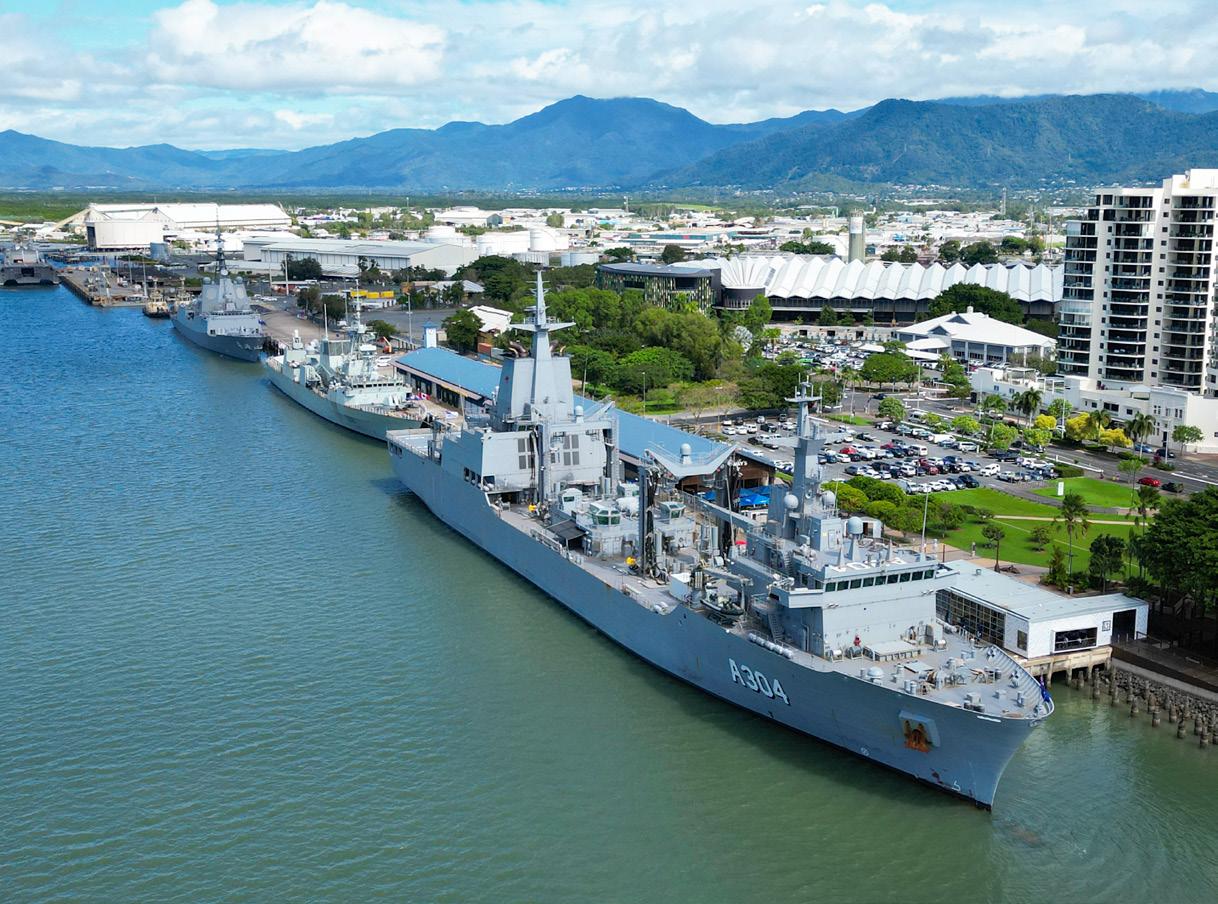
CAIRNS MARINE PRECINCT
The Cairns Marine Precinct is a critical enabler of the Far North Queensland economy and is central to building a sustainable, diversified future for the region. A leading maritime maintenance, repair and overhaul destination for vessels nationally and internationally, the precinct is home to a large and diverse marine sector including Defence and Border Force, a world-renowned tourism-reef fleet, commercial fishing and shipping, specialist boat builders and an active cruising yacht squadron, while also playing host to superyachts and cruise liners visiting the region. The precinct also offers education and training pathways delivered by the TAFE Great Barrier Reef International Marine College which are building the workforce for the future as well as playing a key role in capacity building across the Pacific.
P 28 ADVANCE CAIRNS | 2024-25 QUEENSLAND BUDGET SUBMISSION
Common User Facility
The Cairns Marine Precinct (CMP) has continued to face rapidly growing demand domestically and globally, with maintenance, repair and overhaul (MRO) providers operating at or near capacity and struggling to meet market demand1
Federal and state governments have committed $360m towards the delivery of a maritime Common User Facility (CUF) to increase the capacity and capability of the CMP, allowing the precinct to deliver on future defence and maritime industry business. Given the work that is currently being turned away, it is now vital federal and state governments work together to ensure delivery of the CMP CUF whilst, critically, also ensuring sufficient funding to deliver on the project in its complete scope is allocated. The importance of this project becomes even more apparent in the context of the current geopolitical environment and increased focus on engagement with the Indo-Pacific.
In April 2023, the Australian Government’s Defence Strategic Review outlined the force structure, posture and capability of the Australian Defence Force (ADF) over the coming decades. Key to this and one of six key priority areas identified by the Albanese Government was the need to improve the ADF’s ability to operate from Australia’s northern bases. As Australia’s most northern naval base on the eastern seaboard, HMAS Cairns plays a key strategic role in the nation’s defence capability and is currently undergoing a $240m upgrade. This includes infrastructure required to accommodate the new Arafura-class Offshore Patrol Vessels (OPVs), with HMAS Cairns originally identified to homeport at least four of the planned 12 OPVs. The recent Federal Government Navy Surface Combatant Fleet review confirmed that acquisition of the OPVs would be reduced from 12 to six. Given the original intention to homeport four vessels at HMAS Cairns, and consistent with Defence’s move to consolidate operations in core geographic locations, HMAS Cairns and the CMP, provides Defence with the opportunity to establish Cairns as the nation’s centre of excellence for the OPVs, homeporting and subsequently sustaining all six vessels here.
The potential to home port, maintain and sustain all six OPVs, in addition to opportunities to accommodate other minor war vessels, further underpins the need to commit to the delivery of the shiplift and ensure the region, and Queensland more broadly, harness the opportunity for expansion of the Defence Industry.
In addition to HMAS Cairns, the precinct is also home to the first of four strategically located Regional Maintenance Centres (RMC) established under Defence’s Plan Galileo. RMCs are tasked with the ongoing maintenance and sustainment of multiple classes of Royal Australian Navy surface fleet as a result of the continuous naval shipbuilding program.
Delivery of the CUF would also see Queensland support and strengthen Australia’s strategic, partnerships, alliances and dialogues such as AUKUS and the QUAD. Cairns’ strategic importance and longstanding status as the premier
maintenance and sustainment destination for the region has seen a significant increase in visitation from foreign Defence and border force vessels with this trend only expected to escalate.
In order to meet growing demand and capitalise on these time sensitive defence and maritime opportunities while supporting local industry, it is vital the Queensland Government work with the Australian Government to ensure delivery of the CMP CUF as well as ensuring sufficient funding is provided to deliver the full scope of the project.
In the interim, the Queensland Government is urged to accelerate allocation of $12m (matched funding) for the city’s three shipyards pledged as part of the Industry Partnership Program. These upgrades are the latest phase of government investment in building sovereign capability in the yards - with ongoing investment required given the significance of the assets in the region.
Opportunity
• Strengthen and diversify FNQ economy, building a more sustainable future.
• Increase capability, capacity and competitiveness.
• Solidify Cairns as a leading maritime MRO destination.
• Boost job creation and secure future of 4,600 jobs supported by the Cairns maritime industry.
• Attract investment and re-investment.
• Progresses the Queensland Defence Industries 10-year roadmap.
• Progresses the Queensland Superyacht Strategy 20182028.
Project Status
$360m committed (50:50 funding split)
Works were set to commence in late 2023, weather and other circumstances permitting.
Accelerated delivery is required.
Recommendation
To meet rapidly growing demand and realise full economic benefit, the Queensland Government works with the Australian Government to expedite delivery of the Cairns maritime Common User Facility and commit to having an operational ship lift, undercover facilities and hardstands by 2028.
180 million Australian Government $ $180 million Queensland Government ADVANCE CAIRNS | 2024-25 QUEENSLAND BUDGET SUBMISSION P 29
HMAS Cairns Royal Australian Navy Base
• Undergoing $240m upgrade to accommodate at least four of the 12 Arafura-class Offshore Patrol Vessels
• Regional Maintenance Centre
• 900 Navy and civillian personnel
• Home port of seven Navy Vessels
Common User Facility
• 5,000 tonne shiplift
• Two blast and paint facilities
• Additional wet berth capacity
• 92m wharf
• Three hardstand areas for vessels up to 120m in length
TAFE Queensland Great Barrier Reef International Marine College
• 20m commercially registered vessel
• Desktop simulators
• Engineering workshops
• Full mission bridge simulator
• Multi-purpose Emergency Response Training Simulator (MERTS)
• Sea survival training immersion pool
• Tug optimised bridge
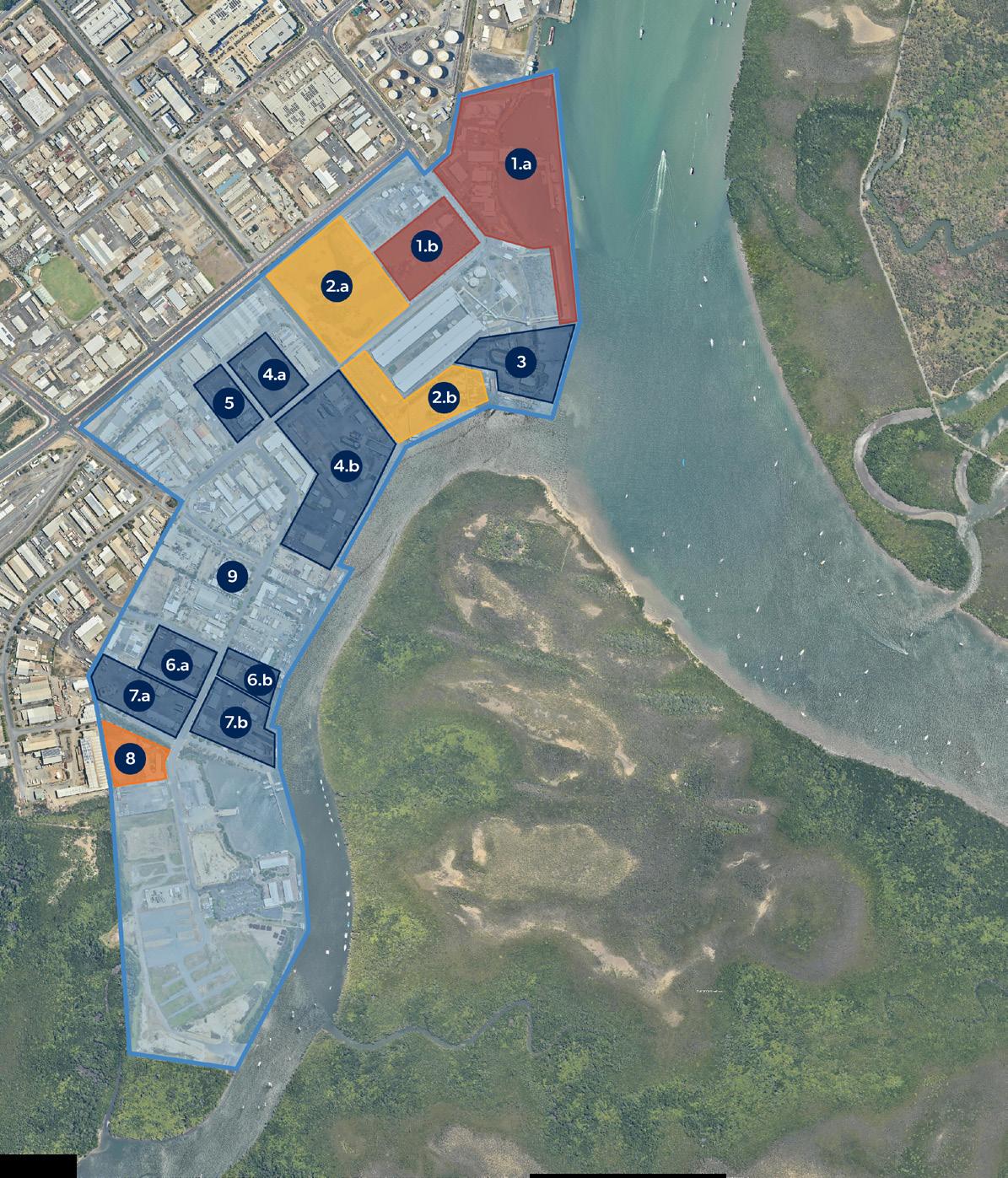
Cairns Marine Precinct
Common User Facility
TAFE Queensland Great Barrier
Reef International Marine College
HMAS Cairns Royal Navy Base
Key stakeholders
1.a/b HMAS Cairns Royal Australian Naval Base
2.a/b Common User Facility
3. Tropical Reef Shipyard
4.a/b Austal
5. NORSTA Maritime
6.a/b Sea Swift
7.a/b Norship
8. TAFE Great Barrier Reef International Marine College
9. Ports North is a key stakeholder and major land holder
P 30 ADVANCE CAIRNS | 2024-25 QUEENSLAND BUDGET SUBMISSION
TAFE Queensland Great Barrier Reef International Marine College
The TAFE Queensland Great Barrier Reef International Marine College continues to expand its range of industryleading marine training capabilities, offering domestic and international students specialised maritime training, including the delivery of Defence’s Pacific Maritime Training Services.
The provision of mandatory training for mariners across commercial and defence vessels, a material maritime skills shortage and the anticipated training required to support Regional Maintenance Centre North East, combine to see the current campus unable to meet growing demand.
In the 2023-24 Queensland Budget, the government committed $16m to deliver an extra 2,675m2 for a new workshop, additional classrooms, staff facilities and a boat shed as well as increased training opportunities.
Cairns Marine Precinct Sources
1 PricewaterhouseCoopers (2022). Cairns Marine Precinct Infrastructure Investment Detailed Business Case.
2 https://www.defence.gov.au/business-industry/naval-shipbuilding/plan/galileo
• Increase education and training capacity, including an expansion of education offerings.
• Enable the delivery of credentials which support future defence sustainment demand.
• Support up to 37 jobs during construction.
Project Status Opportunity
$16m committed.
Construction expected to commence in Q1 2024 with completion by mid-2025.
Government
$16 million
Recommendation
The Queensland Government delivers on its $16m investment to expand the TAFE Great Barrier Reef International Marine College, with construction to commence at the start of 2024 and completion of the project by mid-2025.
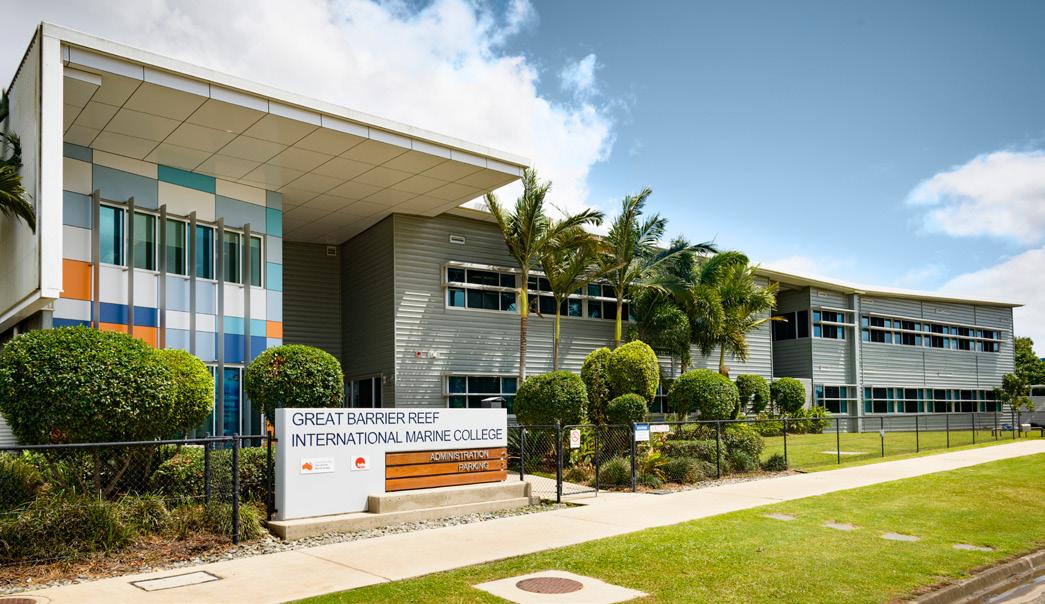 Queensland
Queensland
ADVANCE CAIRNS | 2024-25 QUEENSLAND BUDGET SUBMISSION P 31
Jacinta Reddan ceo@advancecairns.com +61 7 4080 2900 www.advancecairns.com Advance Cairns 2024-25 Queensland Budget Submission March 2024 THE COMMITTEE FOR TROPICAL NORTH QUEENSLAND














 Queensland
Queensland